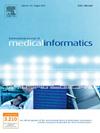A web-based tool utilizing machine learning algorithms for predicting illicit drug use in emergency departments
IF 4.1
2区 医学
Q2 COMPUTER SCIENCE, INFORMATION SYSTEMS
International Journal of Medical Informatics
Pub Date : 2025-06-30
DOI:10.1016/j.ijmedinf.2025.106031
引用次数: 0
Abstract
Background
Identifying illicit drug use through urine testing is time-consuming in the era of new psychoactive substances. This study aimed to develop a machine learning (ML) prediction model for early identification of illicit drug use in suspected emergency department (ED) patients.
Methods
Data from the Taiwan Emergency Department Drug Abuse Surveillance (TEDAS) database (2020–2023) was used. Six feature categories—demographics, triage data, referral source, symptoms, physical findings, and clinical characteristics—were included. The primary outcome was positive urine results for illicit drugs, confirmed by liquid chromatography-tandem mass spectrometry. Data were divided chronologically into training/validation and testing sets. Three supervised ML algorithms, including random forest, CatBoost, and light gradient boosting machine, were tested using K-fold cross-validation, and performance was evaluated by the area under the receiver operating characteristic curve (AUC) in the test set.
Results
The analysis included 13,615 urine test results from ED cases, identifying 3,185 positive cases (23.4%). A total of 9,529 cases (2020–2022) formed the training/validation cohort, and 4,086 (2023) were used for testing. Twenty features were used to construct the prediction model. The CatBoost classifier performed best, achieving an AUC of 0.846 (95% confidence interval [CI]: 0.831–0.859) in the testing cohort. A web-based tool and mobile apps were implemented to assist emergency physicians in predicting illicit drug use.
Conclusions
The machine learning model effectively predicts illicit drug use in ED patients and has been successfully implemented for free access. Further analysis is needed to assess post-implementation performance and its potential for use in other countries.

利用机器学习算法预测急诊科非法药物使用的网络工具
背景在新的精神活性物质时代,通过尿液检测来识别非法药物使用是非常耗时的。本研究旨在开发一种机器学习(ML)预测模型,用于早期识别疑似急诊科(ED)患者的非法药物使用。方法采用台湾省急诊科药物滥用监测(TEDAS)数据库2020-2023年的数据。包括六个特征类别:人口统计学、分诊数据、转诊来源、症状、体格检查和临床特征。主要结果为尿液违禁药物阳性,经液相色谱-串联质谱法证实。数据按时间顺序分为训练/验证集和测试集。采用K-fold交叉验证对随机森林、CatBoost和光梯度增强机三种监督式机器学习算法进行了测试,并通过测试集中的接收者工作特征曲线下面积(AUC)来评估性能。结果共收集ED患者尿检13615例,阳性3185例(23.4%)。总共9529例(2020-2022)形成了培训/验证队列,4086例(2023)用于测试。使用20个特征来构建预测模型。CatBoost分类器表现最好,在测试队列中实现了0.846(95%置信区间[CI]: 0.831-0.859)的AUC。实施了一个基于网络的工具和移动应用程序,以协助急诊医生预测非法药物的使用。结论该机器学习模型能有效预测急诊科患者的非法药物使用情况,并已成功实现免费获取。需要进一步分析评估执行后的业绩及其在其他国家使用的潜力。
本文章由计算机程序翻译,如有差异,请以英文原文为准。
求助全文
约1分钟内获得全文
求助全文
来源期刊

International Journal of Medical Informatics
医学-计算机:信息系统
CiteScore
8.90
自引率
4.10%
发文量
217
审稿时长
42 days
期刊介绍:
International Journal of Medical Informatics provides an international medium for dissemination of original results and interpretative reviews concerning the field of medical informatics. The Journal emphasizes the evaluation of systems in healthcare settings.
The scope of journal covers:
Information systems, including national or international registration systems, hospital information systems, departmental and/or physician''s office systems, document handling systems, electronic medical record systems, standardization, systems integration etc.;
Computer-aided medical decision support systems using heuristic, algorithmic and/or statistical methods as exemplified in decision theory, protocol development, artificial intelligence, etc.
Educational computer based programs pertaining to medical informatics or medicine in general;
Organizational, economic, social, clinical impact, ethical and cost-benefit aspects of IT applications in health care.
 求助内容:
求助内容: 应助结果提醒方式:
应助结果提醒方式:


